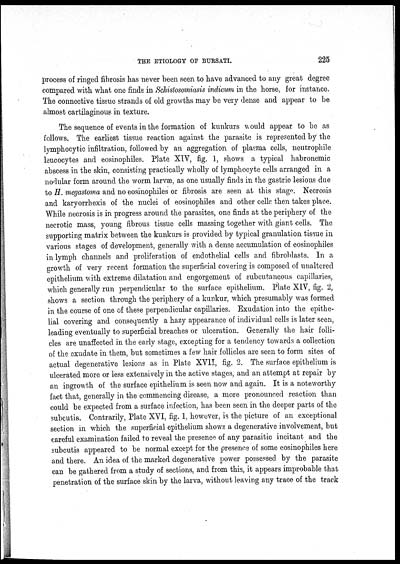Medicine - Veterinary > Veterinary colleges and laboratories > Indian journal of veterinary science and animal husbandry > Volume 3, 1933 > Original articles > Etiology of bursati
(283) Page 225
Download files
Individual page:
Thumbnail gallery: Grid view | List view

THE ETIOLOGY OF BURSATI. 225
process of ringed fibrosis has never been seen to have advanced to any great degree
compared with, what one finds in Schistosomiasis indicum in the horse, for instance.
The connective tissue strands of old growths may be very dense and appear to be
almost cartilaginous in texture.
The sequence of events in the formation of kunkurs would appear to be as
follows. The earliest tissue reaction against the parasite is represented by the
lymphocytic infiltration, followed by an aggregation of plasma cells, neutrophile
leucocytes and eosinophiles. Plate XIV, fig. 1, shows a typical habronemic
abscess in the skin, consisting practically wholly of lymphocyte cells arranged in a
nodular form around the worm larvæ, as one usually finds in the gastric lesions due
to H. megastoma and no eosinophiles or fibrosis are seen at this stage. Necrosis
and karyorrhexis of the nuclei of eosinophiles and other cells then takes place.
While necrosis is in progress around the parasites, one finds at the periphery of the
necrotic mass, young fibrous tissue cells massing together with giant cells. The
supporting matrix between the kunkurs is provided by typical granulation tissue in
various stages of development, generally with a dense accumulation of eosinophiles
in lymph channels and proliferation of endothelial cells and fibroblasts. In a
growth of very recent formation the superficial covering is composed of unaltered
epithelium with extreme dilatation and engorgement of subcutaneous capillaries,
which generally run perpendicular to the surface epithelium. Plate XIV, fig. 2,
shows a section through the periphery of a kunkur, which presumably was formed
in the course of one of these perpendicular capillaries. Exudation into the epithe-
lial covering and consequently a hazy appearance of individual cells is later seen,
leading eventually to superficial breaches or ulceration. Generally the hair folli-
cles are unaffected in the early stage, excepting for a tendency towards a collection
of the exudate in them, but sometimes a few hair follicles are seen to form sites of
actual degenerative lesions as in Plate XVII, fig. 2. The surface epithelium is
ulcerated more or less extensively in the active stages, and an attempt at repair by
an ingrowth of the surface epithelium is seen now and again. It is a noteworthy
fact that, generally in the commencing disease, a more pronounced reaction than
could be expected from a surface infection, has been seen in the deeper parts of the
subcutis. Contrarily, Plate XVI, fig. 1, however, is the picture of an exceptional
section in which the superficial epithelium shows a degenerative involvement, but
careful examination failed to reveal the presence of any parasitic incitant and the
subcutis appeared to be normal except for the presence of some eosinophiles here
and there. An idea of the marked degenerative power possessed by the parasite
can be gathered from a study of sections, and from this, it appears improbable that
penetration of the surface skin by the larva, without leaving any trace of the track
Set display mode to: Large image | Zoom image | Transcription
Images and transcriptions on this page, including medium image downloads, may be used under the Creative Commons Attribution 4.0 International Licence unless otherwise stated. ![]()
| Permanent URL | https://digital.nls.uk/75230323 |
|---|
| Description | Covers articles from 1933. |
|---|




